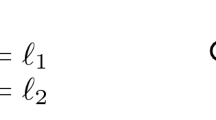Abstract
Finding dense communities in networks is a widely-used tool for analysis in graph mining. A popular choice for finding such communities is to find subgraphs with a high average degree. While useful, interpreting such subgraphs may be difficult. On the other hand, many real-world networks have additional information, and we are specifically interested in networks that have labels on edges. In this paper, we study finding dense subgraphs that can be explained with the labels on edges. More specifically, we are looking for a set of labels so that the induced subgraph has a high average degree. There are many ways to induce a subgraph from a set of labels, and we study two cases: First, we study conjunctive-induced dense subgraphs, where the subgraph edges need to have all labels. Secondly, we study disjunctive-induced dense subgraphs, where the subgraph edges need to have at least one label. We show that both problems are NP-hard. Because of the hardness, we resort to greedy heuristics. We show that we can implement the greedy search efficiently: the respective running times for finding conjunctive-induced and disjunctive-induced dense subgraphs are in \({{\mathcal {O}}\left( p \log k\right) }\) and \({{\mathcal {O}}\left( p \log ^2 k\right) }\), where p is the number of edge-label pairs and k is the number of labels. Our experimental evaluation demonstrates that we can find the ground truth in synthetic graphs and that we can find interpretable subgraphs from real-world networks.
Access this chapter
Tax calculation will be finalised at checkout
Purchases are for personal use only
Similar content being viewed by others
References
Abello, J., Resende, M.G.C., Sudarsky, S.: Massive quasi-clique detection. In: Rajsbaum, S. (ed.) LATIN 2002. LNCS, vol. 2286, pp. 598–612. Springer, Heidelberg (2002). https://doi.org/10.1007/3-540-45995-2_51
Angel, A., Koudas, N., Sarkas, N., Srivastava, D., Svendsen, M., Tirthapura, S.: Dense subgraph maintenance under streaming edge weight updates for real-time story identification. VLDB J. 23(2), 175–199 (2014)
Balasundaram, B., Butenko, S., Hicks, I.V.: Clique relaxations in social network analysis: the maximum \(k\)-plex problem. Oper. Res. 59(1), 133–142 (2011)
Bonchi, F., Khan, A., Severini, L.: Distance-generalized core decomposition. In: SIGMOD, pp. 1006–1023 (2019)
Brodal, G.S., Jacob, R.: Dynamic planar convex hull. In: FOCS, pp. 617–626 (2002)
Bron, C., Kerbosch, J.: Algorithm 457: finding all cliques of an undirected graph. Commun. ACM 16(9), 575–577 (1973)
Charikar, M.: Greedy approximation algorithms for finding dense components in a graph. In: Jansen, K., Khuller, S. (eds.) APPROX 2000. LNCS, vol. 1913, pp. 84–95. Springer, Heidelberg (2000). https://doi.org/10.1007/3-540-44436-X_10
Du, X., Jin, R., Ding, L., Lee, V.E., Thornton Jr, J.H.: Migration motif: a spatial-temporal pattern mining approach for financial markets. In: KDD, pp. 1135–1144 (2009)
Fratkin, E., Naughton, B.T., Brutlag, D.L., Batzoglou, S.: Motifcut: regulatory motifs finding with maximum density subgraphs. Bioinformatics 22(14), e150–e157 (2006)
Galbrun, E., Gionis, A., Tatti, N.: Overlapping community detection in labeled graphs. DMKD 28(5), 1586–1610 (2014)
Goldberg, A.V.: Finding a maximum density subgraph. University of California Berkeley Technical report (1984)
Håstad, J.: Clique is hard to approximate within \(n^{1 - \epsilon }\). In: FOCS, pp. 627–636 (1996)
Langston, M.A., et al.: A combinatorial approach to the analysis of differential gene expression data. In: Shoemaker, J.S., Lin, S.M. (eds.) Methods of Microarray Data Analysis, pp. 223–238. Springer, Boston (2005). https://doi.org/10.1007/0-387-23077-7_17
Li, F., Klette, R.: Convex hulls in the plane. In: Li, F., Klette, R. (eds.) Euclidean Shortest Paths: Exact or Approximate Algorithms, pp. 93–125. Springer, London (2011). https://doi.org/10.1007/978-1-4471-2256-2_4
Mokken, R.J.: Cliques, clubs and clans. Qual. Quant. 13(2), 161–173 (1979)
Overmars, M.H., Van Leeuwen, J.: Maintenance of configurations in the plane. J. Comput. Syst. Sci. 23(2), 166–204 (1981)
Pool, S., Bonchi, F., van Leeuwen, M.: Description-driven community detection. TIST 5(2), 1–28 (2014)
Seidman, S.B.: Network structure and minimum degree. Soc. Netw. 5(3), 269–287 (1983)
Tang, J., Zhang, J., Yao, L., Li, J., Zhang, L., Su, Z.: Arnetminer: extraction and mining of academic social networks. In: KDD, pp. 990–998 (2008)
Tatti, N.: Density-friendly graph decomposition. TKDD 13(5), 1–29 (2019)
Tsourakakis, C.E.: The k-clique densest subgraph problem. In: WWW, pp. 1122–1132 (2015)
Uno, T.: An efficient algorithm for solving pseudo clique enumeration problem. Algorithmica 56(1), 3–16 (2010)
Acknowledgements
This research is supported by the Academy of Finland projects MALSOME (343045).
Author information
Authors and Affiliations
Corresponding author
Editor information
Editors and Affiliations
Rights and permissions
Copyright information
© 2022 The Author(s), under exclusive license to Springer Nature Switzerland AG
About this paper
Cite this paper
Kumpulainen, I., Tatti, N. (2022). Community Detection in Edge-Labeled Graphs. In: Pascal, P., Ienco, D. (eds) Discovery Science. DS 2022. Lecture Notes in Computer Science(), vol 13601. Springer, Cham. https://doi.org/10.1007/978-3-031-18840-4_33
Download citation
DOI: https://doi.org/10.1007/978-3-031-18840-4_33
Published:
Publisher Name: Springer, Cham
Print ISBN: 978-3-031-18839-8
Online ISBN: 978-3-031-18840-4
eBook Packages: Computer ScienceComputer Science (R0)




